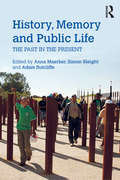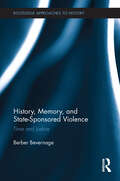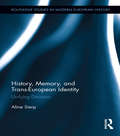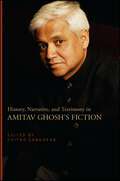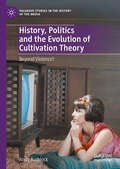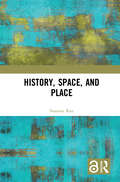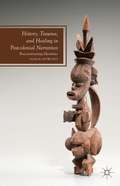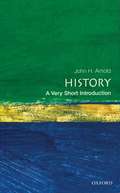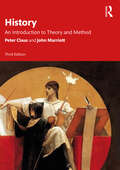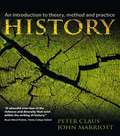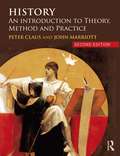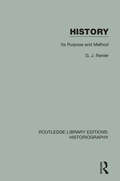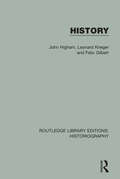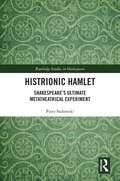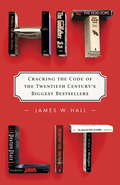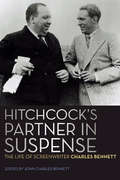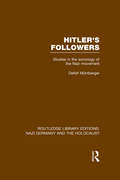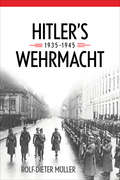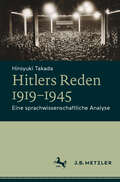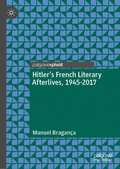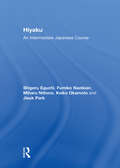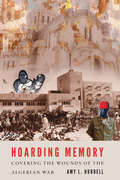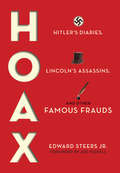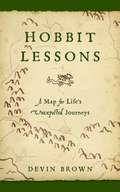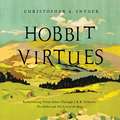- Table View
- List View
History, Memory and Public Life: The Past in the Present
by Adam Sutcliffe Anna Maerker Simon SleightHistory, Memory and Public Life introduces readers to key themes in the study of historical memory and its significance by considering the role of historical expertise and understanding in contemporary public reflection on the past. Divided into two parts, the book addresses both the theoretical and applied aspects of historical memory studies. ‘Approaches to history and memory‘ introduces key methodological and theoretical issues within the field, such as postcolonialism, sites of memory, myths of national origins, and questions raised by memorialisation and museum presentation. ‘Difficult pasts‘ looks at history and memory in practice through a range of case studies on contested, complex or traumatic memories, including the Northern Ireland Troubles, post-apartheid South Africa and the Holocaust. Examining the intersection between history and memory from a wide range of perspectives, and supported by guidance on further reading and online resources, this book is ideal for students of history as well as those working within the broad interdisciplinary field of memory studies.
History, Memory, and State-Sponsored Violence: Time and Justice (Routledge Approaches to History)
by Berber BevernageModern historiography embraces the notion that time is irreversible, implying that the past should be imagined as something ‘absent’ or ‘distant.’ Victims of historical injustice, however, in contrast, often claim that the past got ‘stuck’ in the present and that it retains a haunting presence. History, Memory, and State-Sponsored Violence is centered around the provocative thesis that the way one deals with historical injustice and the ethics of history is strongly dependent on the way one conceives of historical time; that the concept of time traditionally used by historians is structurally more compatible with the perpetrators’ than the victims’ point of view. Demonstrating that the claim of victims about the continuing presence of the past should be taken seriously, instead of being treated as merely metaphorical, Berber Bevernage argues that a genuine understanding of the ‘irrevocable’ past demands a radical break with modern historical discourse and the concept of time. By embedding a profound philosophical reflection on the themes of historical time and historical discourse in a concrete series of case studies, this project transcends the traditional divide between ‘empirical’ historiography on the one hand and the so called ‘theoretical’ approaches to history on the other. It also breaks with the conventional ‘analytical’ philosophy of history that has been dominant during the last decades, raising a series of long-neglected ‘big questions’ about the historical condition – questions about historical time, the unity of history, and the ontological status of present and past –programmatically pleading for a new historical ethics.
History, Memory, and Trans-European Identity: Unifying Divisions (Routledge Studies in Modern European History #23)
by Aline SierpThis book questions the presupposition voiced by many historians and political scientists that political experiences in Europe continue to be interpreted in terms of national history, and that a European community of remembrance still does not exist. By tracing the evolution of specific memory cultures in two successor countries of the Fascist/Nazi regime (Italy and Germany) and the impact of structural changes upon them, the book investigates wider democratic processes, particularly concerning the conservation and transmission of values and the definition of identity on different levels. It argues that the creation of a transnational European memory culture does not necessarily imply the erasure of national and local forms of remembrance. It rather means the creation of a further supranational arena where diverging memories can find their expression and can be dealt with in a different way. Through the triangulation of agents of memory construction, constraints and opportunities and actual portrayals of the past, this volume explores the difficulties faced by a multinational entity like the EU in reaching some kind of consensus on such a sensitive subject as history.
History, Narrative, and Testimony in Amitav Ghosh's Fiction
by Chitra SankaranThis is the first collection of international scholarship on the fiction of Amitav Ghosh. Ghosh's work is read by a wide audience and is well regarded by general readers, critics, and scholars throughout the world. Born in India, Ghosh has lived in India, the United Kingdom, and the United States. His work spans genres from contemporary realism to historical fiction to science fiction, but has consistently dealt with the dislocations, violence, and meetings of peoples and cultures engendered by colonialism.The essays in this volume analyze Ghosh's novels in ways that yield new insights into concepts central to postcolonial and transnational studies, making important intertextual connections and foregrounding links to prevailing theoretical and speculative scholarship. The work's introduction argues that irony is central to Ghosh's vision and discusses the importance of the concepts of "testimony" and "history" to Ghosh's narratives. An invaluable interview with Amitav Ghosh discusses individual works and the author's overall philosophy.
History, Politics and the Evolution of Cultivation Theory: Beyond Violence? (Palgrave Studies in the History of the Media)
by Andy RuddockThis book provides a cultural history of cultivation theory, a North American mass communication paradigm best known for arguing that television violence was a potent agent of political socialisation. Decades after its inception, cultivation theory remains an evocative force in imagining twenty-first-century media power. This book reveals how many factors shaped the theory: the spectre of twentieth-century fascism, the Cold War, political turbulence in 1960s America, and the realisation that television had profoundly altered the rhythms of social and political life. The book also explains how cultivation theory became a means of analysing diverse media influences, thanks to various scholars who brought different motivations, perspectives and skills to the project. Cultivation theory succeeded because its practitioners related their work to the changing political moods of post-war America. In doing so, they created a unique critical perspective within mass communication research, which continues to shed light on the role media play in political conflict.
History, Space and Place
by Susanne RauSpaces, too, have a history. And history always takes place in spaces. But what do historians mean when they use the word "spaces"? And how can spaces be historically investigated? Susanne Rau provides a survey of the history of Western concepts of space, opens up interdisciplinary approaches to the phenomenon of space in fields ranging from physics and geography to philosophy and sociology, and explains how historical spatial analysis can be methodologically and conceptually conceived and carried out in practice. The case studies presented in the book come from the fields of urban history, the history of trade, and global history including the history of cartography, but its analysis is equally relevant to other fields of inquiry. This book offers the first comprehensive introduction to the theory and methodology of historical spatial analysis.
History, Trauma, and Healing in Postcolonial Narratives: Reconstructing Identities (The Future of Minority Studies)
by Ogaga IfowodoWhat would it mean to read postcolonial writings under the prism of trauma? Ogaga Ifowodo tackles these questions through a psycho-social examination of the lingering impact of imperialist domination, resulting in a refreshing complement to the cultural-materialist studies that dominate the field.
History: A Very Short Introduction
by John H. ArnoldStarting with an examination of how historians work, this "Very Short Introduction" aims to explore history in a general, pithy, and accessible manner, rather than to delve into specific periods.
History: An Introduction to Theory and Method
by Peter Claus John MarriottThis book provides an accessible introduction to a wide range of concerns that have preoccupied historians over time. Global in scope, it explores historical perspectives not only from historiography itself but from related areas such as literature, sociology, geography and anthropology which have entered into productive dialogues with history. Clearly written and accessible, this third edition is fully revised with an updated structure and new areas of historical enquiry and themes added, including the history of emotions, video history and global pandemics. In all of this, the authors have attempted to think beyond the boundaries of the West and consider varied approaches to history. They do so by engaging with theoretical perspectives and methodologies that have provided the foundation for good historical practice. The authors analyse how historians can improve their skills by learning about the discipline of historiography, that is, how historians go about the task of exploring the past and determining where the line separating history from other disciplines, such as sociology or geography, runs. History: An Introduction to Theory and Method 3ed is an essential resource for students of historical theory and method working at both an introductory and more advanced level.
History: An Introduction to Theory, Method and Practice
by Peter Claus John MarriottWhy should history students care about theory? What relevance does it have to the "proper" role of the historian? Historiography and historical theory are often perceived as complex subjects, which many history students find frustrating and difficult. Philosophical approaches, postmodernism, anthropology, feminism or Marxism can seem arcane and abstract and students often struggle to apply these ideas in practice. Starting from the premise that historical theory and historiography are fascinating and exciting topics to study, Claus and Marriott guide the student through the various historical theories and approaches in a balanced, comprehensive and engaging way. Packed with intriguing anecdotes from all periods of history and supported by primary extracts from original historical writings, History: An Introduction to Theory, Method and Practice is the student-friendly text which demystifies the subject with clarity and verve. Key features - Written in a clear and witty way. Presents a balanced view of the subject, rather than the polemical view of one historian. Comprehensive - covers the whole range of topics taught on historiography and historical theory courses in suitable depth. Full of examples from different historical approaches - from social, cultural and political history to gender, economic and world history Covers a wide chronological breadth of examples from the ancient and medieval worlds to the twentieth century. Shows how students can engage with the theories covered in each chapter and apply them to their own studies via the "In Practice" feature at the end of each chapter. Includes "Discussion Documents" - numerous extracts from the primary historiographical texts for students to read and reflect upon.
History: An Introduction to Theory, Method and Practice
by Peter Claus John MarriottDemystifying the subject with clarity and verve, History: An Introduction to Theory, Method and Practice familiarizes the reader with the varied spectrum of historical approaches in a balanced, comprehensive and engaging manner. Global in scope, and covering a wide range of topics from the ancient and medieval worlds to the twenty-first century, it explores historical perspectives not only from historiography itself, but from related areas such as literature, sociology, geography and anthropology. Clearly written, accessible and student-friendly, this second edition is fully updated throughout to include: An increased spread of case studies from beyond Europe, especially from American and imperial histories. New chapters on important and growing areas of historical inquiry, such as environmental history and digital history Expanded sections on political, cultural and social history More discussion of non-traditional forms of historical representation and knowledge like film, fiction and video games. Accompanied by a new companion website (www.routledge.com/cw/claus) containing valuable supporting material for students and instructors such as discussion questions, further reading and web links, this book is an essential introduction for all students of historical theory and method.
History: Its Purpose and Method (Routledge Library Editions: Historiography #34)
by G. J. RenierThis treatise of historical methodology, originally published in 1950 is based upon a liberal conception of history which excludes no narrator of past events from the ranks of historians. It defines history as the accurate story which preserves the memory of the past experiences of human societies. The functionof history determines its method and provides the answer to the question: how secure is our knowledge of the past? In the author’s view, history is empirical and its results are for ever provisional. The relative merits of dogmatism and scepticism are examined and several interpretations among English historians are scrutinized.
History: Politics Or Culture? Reflections On Ranke And Burckhardt (Routledge Library Editions: Historiography #1086)
by John Higham Leonard Krieger Felix GilbertThis book, originally published in 1977, is a survey of European historiography from its origins in the historians of Greece and Rome, through the annalists and chroniclers of the middle ages, to the historians of the late eighteenth century. The author concentrates on those writers whose works fit into a specific category of writing, or who have inlfuence the course of later historical writing, though he does deal with some of the more specialist forms of medieval historiography such as the crusading writers, and chivalrous historians like Froissart. He maintains that ‘modern’ history did not develop until the 18th Century.
Histrionic Hamlet: Shakespeare's Ultimate Metatheatrical Experiment (Routledge Studies in Shakespeare)
by Piotr SadowskiAccording to psychological research on acting, the histrionic personality consists of a compulsive tendency to play-act, exaggerate emotions, succumb to illusions, to seek attention through speech, body language, and costume, to be seductive and impulsive. An original intervention in the critical history of Shakespeare’s most famous play, Histrionic Hamlet argues that the Danish Prince is a stage representation of just such a personality—a born actor and a drama queen rather than a politician—incongruously thrown in the middle of ruthless high-stakes power struggle requiring pragmatic rather than theatrical skills. Uniquely among other English revenge tragedies, in Hamlet a histrionic protagonist striking a series of gratuitous, baffling, self-indulgent, and counterproductive poses is called upon to carry out a challenging and brutal political task, which he spectacularly and tragically mismanages. Unable to perform on a theatrical stage as a professional actor, the Clown Prince bitterly play-acts anyway, turning all situations into opportunities of pretend play rather than effective political action. In consequence, he wastes tactical advantages over his enemies, endangers himself, and jeopardizes his revenge plan, if ever there was one. Histrionic Hamlet should be of interest to students of Shakespeare, theater practitioners, and anyone interested in human dysfunctional and maladaptive behavior.
Hit Lit
by James W. HallDISCOVER THE SECRETS OF WHAT MAKES A MEGA-BESTSELLER IN THIS ENTERTAINING, REVELATORY GUIDE What do Michael Corleone, Jack Ryan, and Scout Finch have in common? Creative writing professor and thriller writer James W. Hall knows. Now, in this entertaining, revelatory book, he reveals how bestsellers work, using twelve twentieth-century blockbusters as case studies--including The Godfather, Gone with the Wind, To Kill a Mockingbird, and Jaws. From tempting glimpses inside secret societies, such as submariners in The Hunt for Red October, and Opus Dei in The Da Vinci Code, to vivid representations of the American Dream and its opposite--the American Nightmare--in novels like The Firm and The Dead Zone, Hall identifies the common features of mega-bestsellers. Including fascinating and little-known facts about some of the most beloved books of the last century, Hit Lit is a must-read for fiction lovers and aspiring writers alike, and makes us think anew about why we love the books we love. edition.
Hitchcock's Partner in Suspense: The Life of Screenwriter Charles Bennett (Screen Classics)
by Charles BennettThe colorful life and creative career of the writer behind six of Hitchcock&’s thrillers: &“An intriguing and revealing story.&” —Times Literary Supplement With a career that spanned from the silent era to the 1990s, British screenwriter Charles Bennett lived an extraordinary life. His experiences as an actor, director, playwright, film and television writer, and novelist in both England and Hollywood left him with many amusing anecdotes, opinions about his craft, and impressions of the many famous people he knew. Among other things, Bennett was a decorated WWI hero, an eminent Shakespearean actor, and an Allied spy and propagandist during WWII, but he is best remembered for his commercially and critically acclaimed collaborations with directors Sir Alfred Hitchcock and Cecil B. DeMille. The fruitful partnership with Hitchcock began after the director adapted Bennett&’s 1929 play Blackmail as the first British sound film. Their partnership produced six thrillers: The Man Who Knew Too Much, The 39 Steps, Sabotage, Secret Agent, Young and Innocent, and Foreign Correspondent. In this witty and intriguing book, Bennett discusses how their collaboration created such famous motifs as the &“wrong man accused&” device and the MacGuffin. He also takes readers behind the scenes with the Master of Suspense, offering his thoughts on the director&’s work, sense of humor, and personal life. Featuring an introduction and additional biographical material from Bennett&’s son, editor John Charles Bennett, Hitchcock&’s Partner in Suspense is a richly detailed narrative of a remarkable yet often-overlooked figure in film history.
Hitler's Followers: Studies in the Sociology of the Nazi Movement (Routledge Library Editions: Nazi Germany and the Holocaust)
by Detlef MuhlbergerWhen originally published in 1991, this book was the first systematic, detailed evaluation of the social structure of the Nazi Party in several regions of Germany during its so-called Kampfzeit phase. Based on extensive archival material, much of it left untouched since the end of the war until Detlef Mühlberger uncovered it, the book demonstrates that the Nazi Party and its major auxiliaries, the SA and the SS mobilized support which was remarkably heterogeneous in social terms. The author reveals that in addition to followers from the middle and upper social classes the Nazi Party enjoyed strong support among the lower class and it was indeed, as it claimed to be a people’s party, or Volkspartei.
Hitler's Wehrmacht, 1935–1945 (Foreign Military Studies)
by Rolf-Dieter MüllerAn &“impressively comprehensive&” study of the Nazi military and its culpability in war crimes by &“one of the foremost historians of World War II&” (Stephen G. Fritz, author of Ostkrieg). Since the end of World War II, Germans have struggled with the legacy of the Wehrmacht—the unified armed forces mobilized by Adolf Hitler in 1935. Historians have vigorously debated whether the Wehrmacht's atrocities represented a break with the past or a continuation of Germany's military traditions. Now available for the first time in English, this meticulously researched yet accessible overview by eminent historian Rolf-Dieter Müller provides a comprehensive analysis of the Wehrmacht, illuminating its role in the horrors of the Third Reich. Müller examines the Wehrmacht's leadership principles, organization, equipment, and training, as well as the front-line experiences of soldiers, airmen, Waffen SS, foreign legionnaires, and volunteers. He skillfully demonstrates how state-directed propaganda and terror influenced the extent to which the militarized citizenry—or Volksgemeinschaft—was transformed under the pressure of total mobilization. Finally, Müller evaluates the army's conduct during the war, from blitzkrieg to the final surrender and charges of war crimes. Brief acts of resistance, such as an officers' &“rebellion of conscience&” in July 1944, embody the repressed, principled humanity of Germany's soldiers. But ultimately, Müller concludes, the Wehrmacht became the &“steel guarantor&” of the criminal Nazi regime.
Hitlers Reden 1919–1945: Eine sprachwissenschaftliche Analyse
by Hiroyuki TakadaHitlers Reden spielten eine entscheidende Rolle im Prozess der nationalsozialistischen „Machtergreifung“ und der späteren Durchsetzung ihrer Politik. Das Buch untersucht die Gründe für die enorme Wirkung von Hitlers Auftritten, indem es die 1,7 Millionen Wörter, die die Reden umfassen, systematisch und in ihrer Entwicklung analysiert. Unter Einbeziehung der historischen und technikgeschichtlichen Hintergründe sowie detaillierten Beschreibungen von Hitlers Auftreten, seinen Gesten und rhetorischen Mitteln entsteht so eine Gesamtdarstellung von Hitlers Entwicklung als Redner – von den euphorisierenden Anfängen in den Bierkellern bis zu den kaum mehr beachteten Einlassungen am Ende des Krieges.
Hitler’s French Literary Afterlives, 1945-2017
by Manuel BragançaThis book analyses the successive appearances of Adolf Hitler in French fiction between 1945 and 2017. It discusses why, unlike what has been observed in the US and in the UK, it has proven problematic for French novelists to write about Hitler in their numerous fictional explorations of the Second World War. It examines the literary and ethical challenges of including historical characters such as Hitler in fiction, and demonstrates how these challenges evolved over time as memories of the Second World War also evolved in France.
Hiyaku: An Intermediate Japanese Course
by Keiko Okamoto Shigeru Eguchi Fumiko Nazikian Miharu Nittono Jisuk ParkHiyaku: An Intermediate Japanese Course provides a progressive intermediate course in Japanese, incorporating modern teaching methods and practicing all four language skills. Hiyaku provides content-based instruction, with authentic and semi-authentic dialogues and readings, all carefully selected to instruct and inspire students as they learn Japanese. Key features of the textbook include: highly structured chapters, beginning with warm-up exercises followed by focused practice of each of the four skills gradual introduction to increasingly authentic materials content taken from original Japanese sources such as books, TV programs, magazines, newspapers and websites extensive audio material provided as FREE MP3 files on a companion website instructor’s materials, including PowerPoint files provided through the companion website. Hiyaku does not simply teach language and basic cultural points: it also helps students gain a holistic understanding of Japanese society and history, and provides the necessary foundation for the advanced study of Japan and its language.
Hoarding Memory: Covering the Wounds of the Algerian War
by Amy L. HubbellHoarding Memory looks at the ways the stories of the Algerian War (1954–62) have proliferated among the former French citizens of Algeria. By engaging hoarding as a model, Amy L. Hubbell demonstrates the simultaneously productive and destructive nature of clinging to memory. These memories present massive amounts of material, akin to the stored objects in a hoarder&’s house. Through analysis of fiction, autobiography, art, and history that extensively use collecting, layering, and repetition to address painful war memories, Hubbell shows trauma can be hidden within its own representation.Hoarding Memory dedicates chapters to specific authors and artists who use this hoarding technique: Marie Cardinal, Leïla Sebbar, and Benjamin Stora in writing and Nicole Guiraud and Patrick Altes in art. All were born in Algeria during colonial French rule but in vastly different contexts; each suffered personal or inherited trauma from racism, physical or psychological abuse, terrorist or other violent acts of war, and exile in France. Zineb Sedira&’s artwork is also included as an example of traumatic memory inherited from her parents. Ultimately this book shows how traumatic experience can be conveyed in a seemingly open account that is compounded and compacted by the volume of words, images, and other memorial debris that testify to the pain.
Hoax: Hitler's Diaries, Lincoln's Assassins, and Other Famous Frauds
by Edward Steers Jr.A &“lively yet thoroughly researched&” look at persistent myths and stubborn scams, and how historians try to combat them (The Courier-Journal).Did a collector with a knack for making sensational discoveries really find the first document ever printed in America? Did Hitler actually pen a revealing set of diaries? Has Jesus&’ burial cloth survived the ages? Can the shocking true account of Abraham Lincoln&’s assassination be found in lost pages from his murderer&’s diary?Napoleon famously observed that &“history is a set of lies agreed upon,&” and Edward Steers Jr. investigates six of the most amazing frauds ever to gain wide acceptance in this engrossing book. Hoax examines the legitimacy of the Shroud of Turin, perhaps the most hotly debated relic in all of Christianity, and the fossils purported to confirm humanity&’s &“missing link,&” the Piltdown Man. Steers also discusses two remarkable forgeries, the Hitler diaries and the &“Oath of a Freeman,&” and famous conspiracy theories alleging that Franklin D. Roosevelt had prior knowledge of the planned attack on Pearl Harbor and that the details of Lincoln&’s assassination are recorded in missing pages from John Wilkes Booth&’s journal.The controversies that Steers presents show that there are two major factors involved in the success of a hoax or forgery—greed and the desire to believe. Though all of the counterfeits and conspiracies featured in Hoax have been scientifically debunked, some remain fixed in many people&’s minds as truth. As Steers points out, the success of these frauds highlights a disturbing fact: If true history fails to entertain the public, it is likely to be ignored or forgotten.
Hobbit Lessons: A Map for Life's Unexpected Journeys
by Devin BrownLessons on joy, friendship, dedication, sacrifice, and more will appealto Hobbit fans, parents, teachers, librarians, graduates—and anyonelooking for a creative way to explore timeless life lessons andimportant values of faith.Millions of fans worldwide have beenattracted to The Hobbit for its unique combination of high adventure andprofound truths. Tapping the excitement around the highly-anticipatedHobbit movie trilogy, Tolkien-scholar, Devin Brown, now presents afast-paced and easy-to-follow presentation of timeless spiritualmessages to help navigate your journey. Peppered with illustrationsthroughout, Hobbit Lessons offers troll-sized portions ofrelevance and regular nuggets of good Hobbit sense. The result is acollection of tangible bites of wisdom that are not only deeply movingbut also great fun.
Hobbit Virtues: Rediscovering J. R. R. Tolkien's Ethics from The Lord of the Rings
by Christopher A. SnyderA response to our fractured political discourse, Hobbit Virtues speaks to the importance of &“virtue ethics&” by examining the fiction of J. R. R. Tolkien—with particular attention to his hobbits.Tolkien&’s works resonate with so many readers in part because Bilbo, Frodo, Sam, Merry, and Pippin demonstrate Classical, Judeo-Christian, Medieval, and even Hindu and Confucian virtues. Tolkien ennobles the small, the humble, and the marginalized in his Middle-earth writings and presents leaders who are hesitant to exercise power, are courteous, and value wisdom and learning. Each chapter in Hobbit Virtues consists of a wide-ranging discussion of a single virtue, exemplified by a character in Middle-earth, explaining its philosophical or theological roots and how the virtue is still relevant in a modern democracy. It will also include appendices where readers can find passages in Tolkien&’s and Lewis&’s works that discuss virtue ethics, and a glossary of virtues from ancient to modern, East to West. Tolkien&’s readers come from many different religious and secular backgrounds and the pleasure and profundity of Hobbit Virtues is that mutual respect for public virtues is, especially now, necessary for a well-functioning pluralistic society.
